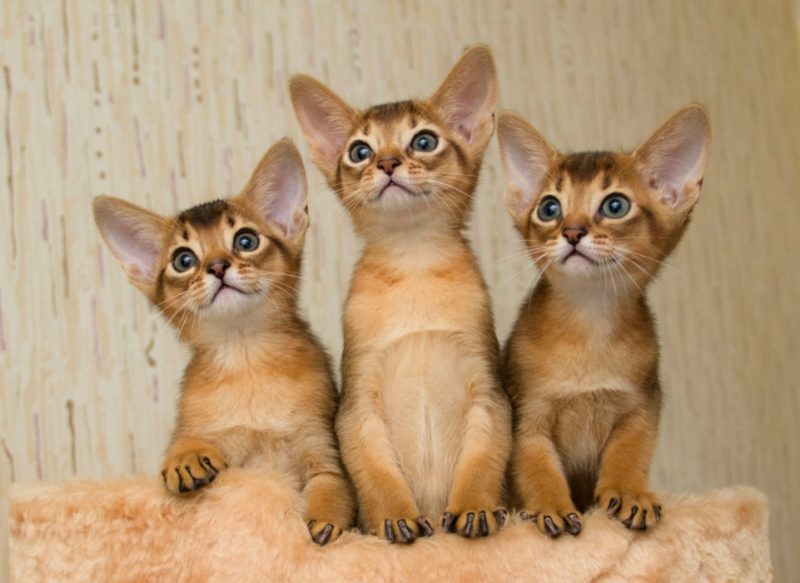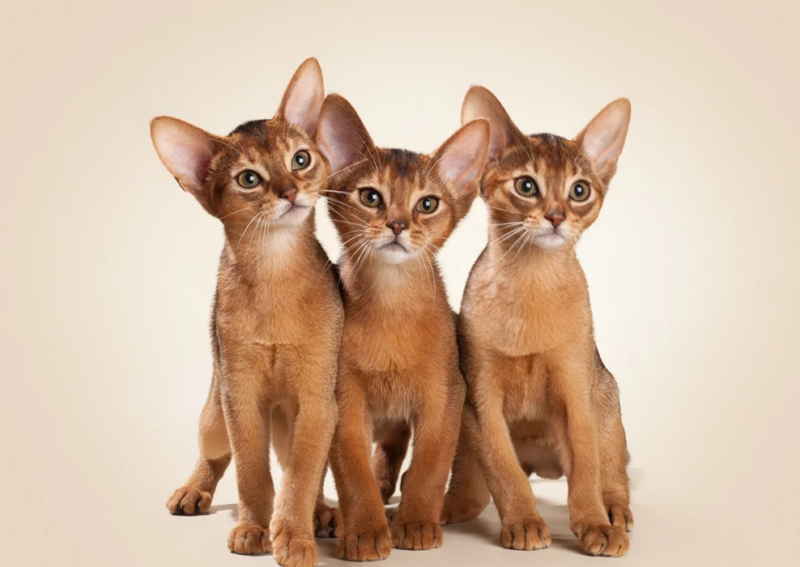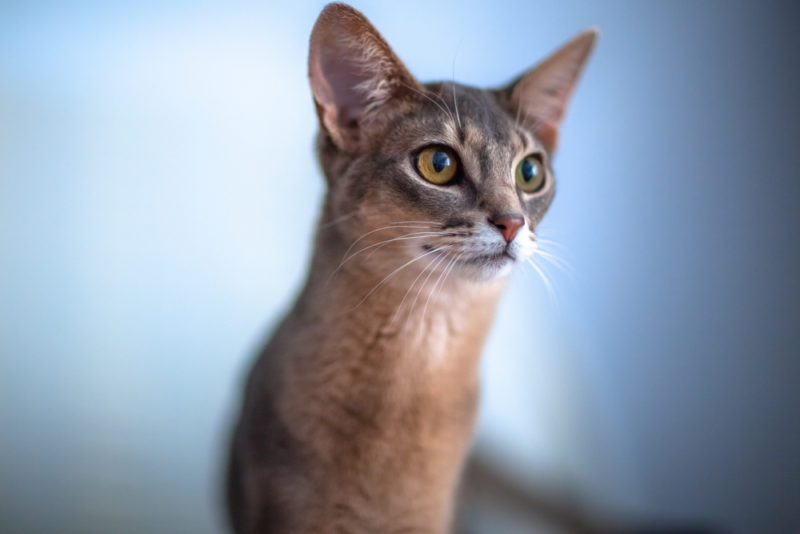Graceful and active Abyssinian kittens with their magnificent appearance are very reminiscent of the wild representatives of large felines. However, unlike the latter, they are very fond of human society and simply immensely loyal to the owner. Instead, animals require a sufficient amount of attention and care, therefore it is better to buy a breed for people who spend a lot of time at home.
Material Content:
Description of the breed of Abyssinian kittens
Kittens of the Abyssinian breed are medium-sized, hosy and flexible animals with an original color and black eyes. The unique external characteristics make it possible to almost unmistakably determine the breed, however, in the process of selection, felinologists began to distinguish 2 types of Abyssinians: European and American.
| Options | European | American |
|---|---|---|
| Body type | More massive | Lightweight and sleeker, narrower |
| Head | Rounded | Slightly narrowed |
| The ears | Medium, straight | Large, wide-set |
| Paws | Shorter | Bit longer |
| Wool | A little longer | Shorter darker |
According to experts, the American type of cats is currently more common.
Regardless of the variety, Abyssinians resemble dogs in their habits. Representatives of the breed have high intelligence, very loyal to the owner and are very amenable to training. Often animals on the heels follow the owner and can even bring an abandoned ball or carry out other simple “dog” commands.
By nature, Abyssinian cats are energetic, inquisitive, playful, but at the same time very calm and delicate. Fidgets are interested in everything around. Having appeared in the house, the animal will surely examine all uncharted surfaces (cabinets, upper shelves or whatnots), and after finishing with the “inspection”, it will settle down somewhere on a hill and observe the owner’s movements. Whenever possible, the cat will “help” cut products to the owner, print an article, fix a tap or turn the page of a book. They can’t be left for a long time: representatives of the breed very urgently need close communication with a person and cannot stand loneliness.
With children and pets (dogs, cats, large parrots) they get along well and never will offend them. Thanks to poise, claws will never be released in response to childish pranks and will rather retreat than start attacking. In some families, Abyssinians even perfectly cope with the role of a nanny for babies. They “guard” the baby’s sleep, and as soon as the baby wakes up, they inform the owners of it with meow.
The voice of cats is soft and melodic. Heartbreaking screams from them will not work. Animals purr more often than voice.
Abyssinians will certainly help to bring the perfect order in the house. Having discovered the scattered things, they will quickly "remove" them under a sofa or bed. Cats love everything new, so they travel with the owners with pleasure.
Origin history
The origin of the breed of Abyssinian cats is shrouded in mystery. According to one version, the animals are directly related to Ancient Ethiopia (Abyssinia), from where they were first taken out after the end of the Anglo-Abyssinian War by Captain Barrett Lenard.
According to another theory, the roots of the breed go to Ancient Egypt. There, the Abyssinian was considered the embodiment of the goddess Bast herself. Kittens were allowed only to the pharaoh and his family members. The proof of this version, according to scientists, was a large number of figurines and images of abyssinians found in tombs.
The third version says that the countries of Southeast Asia or Afghanistan, with which England waged wars, can be called the birthplace of cats. The hypothesis was confirmed by the stuffed Abyssinian cat, which was exhibited in the Netherlands at the Leiden Museum of Zoology.
Be that as it may, in Europe the breed officially appeared at the end of the 19th century and even took 3rd place at the cat show. And after 18 years, its standard was officially published. At the beginning of the twentieth century, Abyssinians came to America, where at the moment they are very popular.
Standard, color and choice of kitten
The CFA standard assumes the following breed characteristics:
- Paws Slender, with thin bones. On the forelimbs - 5 fingers, and on the hind legs - 4.
- Tail. Long, gradually tapering from the base to the tip.
- Head. Wedge-shaped, slightly rounded, with a wide, slightly convex forehead. In adults, cheeks can be clearly expressed.
- The ears. Large, pointed at the ends and wide at the base.
- Eyes. Almond-shaped, large, yellow, green or hazel.
- Wool. Short, thin, pleasant to the touch, hypoallergenic.
Abyssinian cats are on average 28 cm tall and cats 32 cm tall. Representatives of the breed (depending on gender) weigh 3.5 to 7 kg, but it is better if the body weight of an adult animal does not exceed 5 kg.
One of the main features of the Abyssinians is ticked wool, when light and dark stripes alternate on a thread. According to the standard, a tick should be clearly visible even with a saturated coat of wool.
CFA officially recognizes 4 coat colors of animals:
- Blue. The main body part is covered with gray, gray-blue or beige hair of warm colors, and the cat's muzzle and tail are characterized by darker colors.
- Beige (faun). Light brown color harmonizes with areas of cocoa color.
- Sorrel (red). The reddish-red color is combined with chocolate marks.
- Wild.The tail and muzzle of black color complement the coat of black, dark brown or ocher.
Before choosing an Abyssinian kitten, you should pay attention to the following:
- availability of necessary documents (for example, pedigrees and medical records of parents);
- nursery reputation;
- general condition of the animal, its appearance and activity;
- pet health;
- conditions of detention and more.
It is better to take a kitten to a family at 3 months of age. By this moment, the animal will already survive the first molt, and the ticking characteristic of the breed will appear on the coat.
Keeping and feeding a pet
Abyssinians do not require special conditions of detention.
However, to make the animal feel comfortable in the new house, breeders recommend:
- adjust the room temperature (at least 23 ° C);
- equip kittens with houses at a height, climbing walls and claws;
- remove from the apartment harmful indoor feline plants (azalea, hydrangea, ivy and others);
- close windows and window panes with nets;
- hide wires, household chemicals, medicines, small and fragile objects;
- cover the gaps between the walls and furniture.
Because of their curiosity, the breed representatives like to explore the objects and territory surrounding them, so it is also advisable to block pets' access to washing machines, a refrigerator and an oven.
You can feed an Abyssinian kitten:
- chicken or beef (boiled);
- kefir or cottage cheese;
- boneless marine boiled fish;
- fruits and vegetables;
- cereals.
It is strictly forbidden to give the animal:
- river fish;
- fatty meats;
- raw meat (only frozen);
- spice;
- sweets;
- fried and smoked.
Some breeders prefer to give their pets dry food. The most popular brands are Natural kitten food, Royal Canin, Farmina.
Parenting and care
Caring for Abyssinian kittens is easy. It is enough to comb them every 7 days with a special brush. During molting, you can carry out the procedure more often, using a rubber glove.
Once a month, it is advisable to bathe your pets. Representatives of the breed really like water, but more often it is not recommended. You can dry cats without a hair dryer.
Abyssinians are prone to plaque formation. From childhood they must be accustomed to brushing your teeth. Perform the manipulation once every 2 weeks. To cut the claws and inspect the ears once every 7 days.
On a note! Timely vaccination of kittens and regular preventive examination by a veterinarian will relieve other problems.
There are no universal recommendations for raising Abyssinian cats: it all depends on the individuality and nature of the animal. However, the breeders claim that the pets are easily accustomed to the tray and even the toilet, perform the commands “To me”, “Aport”, “You can’t” and others.
It is better to teach a kitten to a car from childhood. Animals are suspicious of harsh sounds and may be scared. In order to avoid an emergency during the first trips, it is better to bring someone with you who will control your pet.
If you plan to walk a cat, it is also worth accustoming it to a harness from childhood. It is enough for several minutes to wear an accessory in the room, gradually increasing the time. The animal will soon get used to the new sensations. It is impossible to close the representatives of the breed in an aviary or cage: cats cannot stand loneliness.
Life span
The life expectancy of Abyssinians is largely dependent on the following factors:
- quality care;
- diseases;
- timely medical care;
- the presence of offspring or castration;
- diet;
- amount of physical activity;
- emotional background and other things.
On average, with proper care, an animal can live about 15-20 years.
Advantages and disadvantages of the breed
The positive characteristics of Abyssinian cats include:
- high intelligence;
- devotion;
- the possibility of training;
- cleanliness;
- easy care.
The disadvantages of the breed are:
- need for increased attention;
- tendency to vandalism;
- the need for room equipment.
Abyssinian kittens rightfully occupy one of the leading positions in the rating of cat breeds. Mind, quick wit, beauty, fidelity and love for the owner make the Abyssinians not just pets, but friends of a person. And proper care and rational nutrition of the animal will make these "relationships" as long as possible.

















